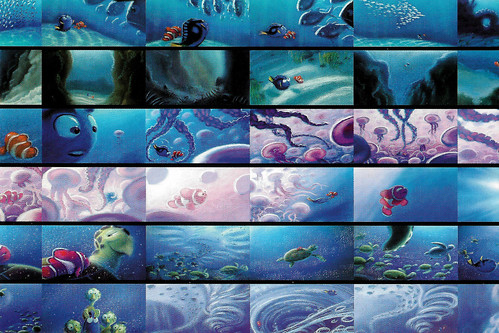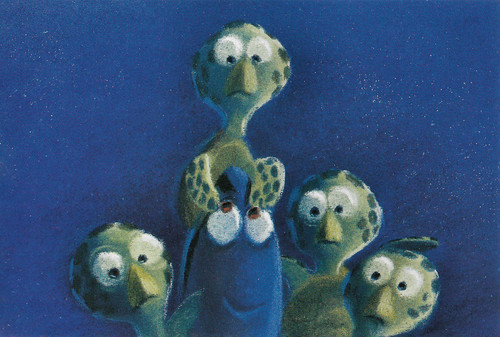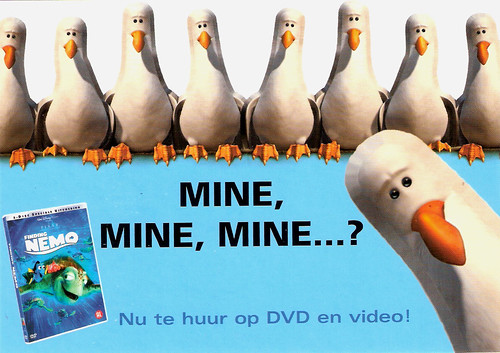
American postcard by Disney Enterprises / Pixar Animation Studios, 2005. Image: Pixar Animation Studios. Film image of Finding Nemo (Andrew Stanton, Lee Unkrich, 2003). From 'The Art of Pixar: 100 Collectible Postcards', published by Chronicle Books.

French postcard by Sonis, no. C. 1413, offered by Teisseire. Image: Disney / Pixar. Film image of Finding Nemo (Andrew Stanton, Lee Unkrich, 2003).

French postcard by Sonis, no. C. 1414. Image: Disney / Pixar. Film image of Finding Nemo (Andrew Stanton, Lee Unkrich, 2003).

French postcard by Sonis, no. C. 1439. Image: Disney / Pixar. Film image of Finding Nemo (Andrew Stanton, Lee Unkrich, 2003). Caption: Grab shell dude!
An overprotective clownfish called Marlin
At the beginning of Finding Nemo (2003), the clownfish Marlin and his wife Coralie have just moved to a new anemone in the Great Barrier Reef. Their happiness is short-lived as Coralie and almost all the eggs she had laid are devoured by a barracuda. Only one egg survives.
Marlin decides to name the little fish from this egg Nemo, a name that Coralie had thought up. In Latin, the word 'nemo' means 'nobody' or 'no one'. It is also a reference to Captain Nemo in Jules Verne's novel '20,000 Leagues Under the Sea'.
Nemo has one fin that is smaller than normal. His father and he call it Nemo's lucky fin. It is actually a kind of scar from the barracuda's attack. The incident also makes Marlin excessively neurotic and protective of Nemo.
When Nemo is older, it is time for him to go to school. The timid Marlin follows Nemo, against his will, to make absolutely sure he is safe. Nemo has clearly had it with his father's behaviour. To prove there is no danger, he leaves the coral reef. However, he is spotted by two divers. One of them catches Nemo in a net and takes him away.
Marlin gets over his fear of the open sea to retrieve Nemo. He meets Dory, a blue tang suffering from short-term memory loss. One of the divers has lost his goggles, and Marlin finds them. The address of the diver is written on the goggles. With the help of Dory, who can read, they find out that Nemo is in Sydney now.
Dory accompanies Marlin to Sydney on his search for Nemo. The two come across, among other things, three vegetarian sharks, a school of jellyfish, and a group of sea turtles. The latter help them a great deal. Finally, Marlin and Dory are swallowed by a humpback whale that blows them out through the blowhole, which carries them the last mile to Sydney.

American postcard by Disney Enterprises / Pixar Animation Studios, 2005. Image: Pixar Animation Studios. Concept art by Ralph Eggleston for Finding Nemo (Andrew Stanton, Lee Unkrich, 2003). From 'The Art of Pixar: 100 Collectible Postcards', published by Chronicle Books.

American postcard by Disney Enterprises / Pixar Animation Studios, 2005. Image: Pixar Animation Studios. Concept art by Ralph Eggleston for Finding Nemo (Andrew Stanton, Lee Unkrich, 2003). From 'The Art of Pixar: 100 Collectible Postcards', published by Chronicle Books.

American postcard by Disney Enterprises / Pixar Animation Studios, 2005. Image: Pixar Animation Studios. Concept art by Ralph Eggleston for Finding Nemo (Andrew Stanton, Lee Unkrich, 2003). From 'The Art of Pixar: 100 Collectible Postcards', published by Chronicle Books.

American postcard by Disney Enterprises / Pixar Animation Studios, 2005. Image: Pixar Animation Studios. Concept art by Ralph Eggleston for Finding Nemo (Andrew Stanton, Lee Unkrich, 2003). From 'The Art of Pixar: 100 Collectible Postcards', published by Chronicle Books.
One of those rare movies where I wanted to sit in the front row
The inspiration for Finding Nemo (2003) sprang from multiple experiences, going back to director Andrew Stanton's childhood, when he loved going to the dentist to see the fish tank, assuming that the fish were from the ocean and wanted to go home. In 1992, shortly after his son was born, he and his family took a trip to Six Flags Discovery Kingdom which was called Marine World at the time. There, after seeing the shark tube and various exhibits, he felt that the underwater world could be done beautifully in computer animation.
Later, in 1997, he took his son for a walk in the park but realized that he was overprotecting him and lost an opportunity to have a father-son experience that day. In an interview with National Geographic magazine, Stanton said that the idea for the characters of Marlin and Nemo came from a photograph of two clownfish peeking out of an anemone: "It was so arresting. I had no idea what kind of fish they were, but I couldn't take my eyes off them. And as an entertainer, the fact that they were called clownfish - it was perfect. There's almost nothing more appealing than these little fish that want to play peekaboo with you."
In addition, clownfish are colourful, but do not tend to come out of an anemone often. For a character who has to go on a dangerous journey, Stanton felt a clownfish was the perfect type of fish for the character. Pre-production of the film began in early 1997. Stanton began writing the screenplay during the post-production of A Bug's Life (John Lasseter, Andrew Stanton, 1998). As a result, Finding Nemo began production with a complete screenplay, something that co-director Lee Unkrich called "very unusual for an animated film".
The artists took scuba diving lessons to study the coral reef. Stanton originally planned to use flashbacks to reveal how Coral died but realized that by the end of the film there would be nothing to reveal, deciding to show how she died at the beginning of the film. Finding Nemo was the first Pixar film not to be scored by Randy Newman. The original soundtrack album, 'Finding Nemo,' was scored by Thomas Newman, his cousin. The score was nominated for the Academy Award for Original Score, losing to The Lord of the Rings: The Return of the King (Peter Jackson, 2003).
Finding Nemo (2003) did win the Academy Award for Best Animated Feature, the first Pixar film to do so. It was also nominated in two more categories, including Best Original Screenplay. Roger Ebert gave the film four out of four stars, calling it "one of those rare movies where I wanted to sit in the front row and let the images wash out to the edges of my field of vision".
Finding Nemo became the highest-grossing animated film at the time of its release, and was the second-highest-grossing film of 2003, earning a total of $871 million worldwide by the end of its initial theatrical run. Demand for tropical fish exploded right after the film's release, especially for clownfish and blue tang. Finding Nemo is also the best-selling DVD title of all time, with over 40 million copies sold as of 2006. After the success of the 3D re-release of The Lion King (Roger Allers, Rob Minkoff, 1994), Disney re-released Finding Nemo in 3D in 2012. A spin-off sequel, Finding Dory (Andrew Stanton, Angus MacLane, 2016), was released in June 2016.

American postcard by Disney Enterprises / Pixar Animation Studios, 2005. Image: Pixar Animation Studios. Film image of Finding Nemo (Andrew Stanton, Lee Unkrich, 2003). From 'The Art of Pixar: 100 Collectible Postcards', published by Chronicle Books.

American postcard by Disney Enterprises / Pixar Animation Studios, 2005. Image: Pixar Animation Studios. Concept art by Ralph Eggleston for Finding Nemo (Andrew Stanton, Lee Unkrich, 2003). From 'The Art of Pixar: 100 Collectible Postcards', published by Chronicle Books.

American postcard by Disney Enterprises / Pixar Animation Studios, 2005. Image: Pixar Animation Studios. Concept art by Ralph Eggleston for Finding Nemo (Andrew Stanton, Lee Unkrich, 2003). From 'The Art of Pixar: 100 Collectible Postcards', published by Chronicle Books.

Dutch postcard. Image: Disney / Pixar. Film Image of Finding Nemo (Andrew Stanton, Lee Unkrich, 2003). Caption: Mine, mine, mine...? Now available to rent on DVD and video.
Sources: Wikipedia (Dutch and English), and IMDb.
No comments:
Post a Comment